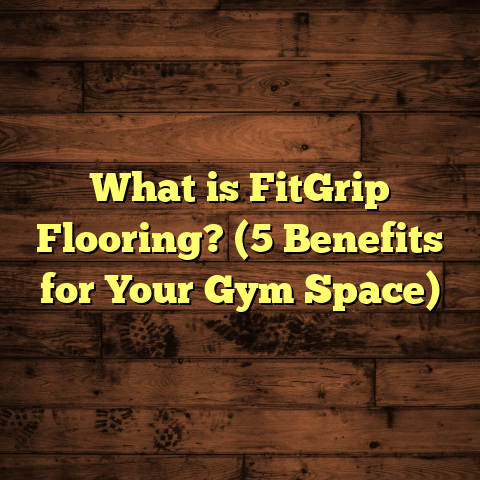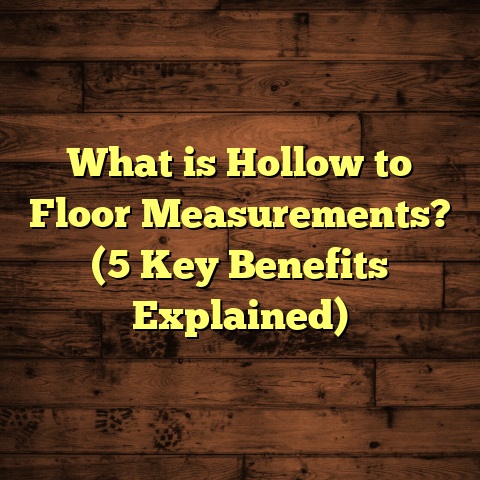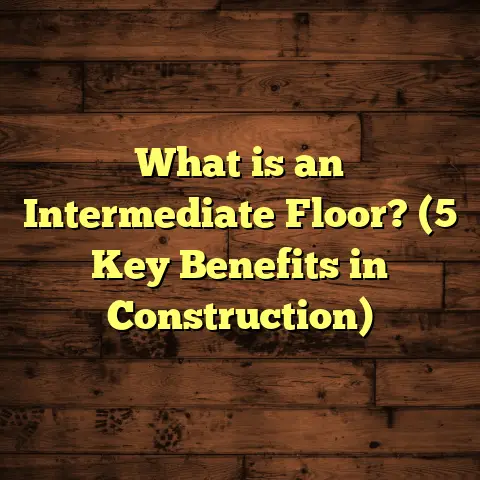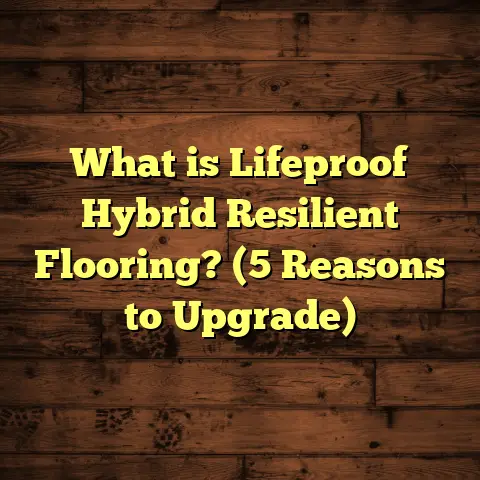What is Nosing in Hardwood Floors? (5 Key Benefits Explained!)
I still remember the satisfying sound my feet made stepping down a wooden staircase in my first hardwood-floored home—the soft creak, the smooth edges beneath my toes. That feeling, the subtle connection between the floor and my steps, is something many don’t notice but plays a big role in how comfortable and safe a space feels. One key part of that experience is something called “nosing,” a detail on hardwood floors that you might overlook but which makes a huge difference.
When I first started working with hardwood floors, nosing was a term I heard thrown around but didn’t fully understand until I saw it in action during an installation. Over time, I’ve come to appreciate how this small design and functional element can transform not only the look but also the safety and durability of staircases and flooring edges.
What is Nosing in Hardwood Floors?
So, what is nosing exactly? In simple terms, nosing refers to the rounded or beveled edge of a stair tread—the part that sticks out slightly beyond the riser (the vertical part of the step). It’s like the lip of the step that your foot touches first as you climb up or down stairs. But nosing isn’t just about staircases; sometimes it’s applied to other hardwood flooring edges to create smooth transitions or protect vulnerable spots.
You’ll often see nosing on hardwood staircases because it adds safety, style, and durability. The shape can vary—some have a soft round curve, others a sharp bevel. The key is that nosing creates a defined edge which helps prevent slips and protects the wood from chipping.
Why Does Nosing Matter?
Imagine walking down stairs where each step edge is sharp and square. It feels awkward underfoot, right? That edge can cause discomfort or even injury if you catch your toes on it. Nosing softens this edge and visually defines each step, making movement easier and safer.
In addition, nosing helps protect the stair tread from damage caused by repeated impact. Without it, the edges chip faster, causing unsightly wear and even structural issues over time.
Types of Nosing Profiles
There are several common profiles for stair nosing:
- Bullnose Nosing: Fully rounded edge, popular for traditional hardwood stairs.
- Beveled Nosing: Angled edge that gives a sleek, modern look.
- Square Edge Nosing: Straight edge with little to no rounding, often found in minimalist designs.
- OGEE Nosing: A decorative edge with curves and steps, often used in classic or ornate styles.
- T-Molding or Overlap Nosing: Used in transitions between floors to cover gaps or height differences.
Each profile has its own aesthetic and functional advantages depending on your home’s style and usage.
Materials Used for Nosing
Most hardwood floor nosings are made from the same species as the flooring itself—oak, maple, cherry, walnut—to maintain color and grain consistency. However, some manufacturers offer composite or engineered wood nosings for cost-saving or moisture resistance.
From my experience, matching the wood species ensures a smooth appearance and similar wear patterns over time.
5 Key Benefits of Nosing in Hardwood Floors
Let me share five benefits of nosing that I’ve seen firsthand over thousands of square feet installed:
1. Enhanced Safety
The primary reason I always recommend nosing on stairs is safety. The rounded or beveled edge provides a better grip for your feet, reducing the risk of slips or trips—especially important if you have kids or elderly family members at home.
Data point: According to the National Safety Council, falls on stairs cause approximately 1 million injuries every year in the U.S., many due to worn or sharp edges. Nosing helps create a tactile edge, giving your foot a clear boundary.
When I installed hardwood stairs for a client with toddlers, we chose bullnose nosing with a textured finish. The parents told me later that they felt much more secure letting their kids run up and down without worry.
2. Increased Durability
The edges of stair treads are naturally vulnerable because they bear most of the impact from foot traffic. Without nosing, these edges can chip or wear down quickly.
From my experience, stair treads without nosing often start showing damage within 3-5 years in busy households. Nosing protects these edges by absorbing impact and preventing splintering.
I’ve seen some older homes with stairs lacking nosing where the wood edges were rounded off unevenly from wear. Adding new nosing restored structural integrity and extended the stairs’ life significantly.
3. Aesthetic Appeal
Nosing adds a finished, polished look to stairs and flooring edges. It can be subtle or bold depending on the profile chosen.
I once helped a client select nosing with a slightly wider lip and rounded edge that matched their traditional hardwood style perfectly. It gave their staircase a timeless elegance that guests still comment on years later.
Beyond looks, nosing helps define each step visually by casting subtle shadows and highlights, enhancing the depth perception on stairs.
4. Smooth Transitions
In areas where hardwood meets other flooring like tile or carpet, nosing can create a smooth transition. This prevents tripping hazards and protects edges from damage caused by foot traffic or vacuum cleaners.
I’ve seen many homes where the lack of proper nosing caused carpet edges to fray or tile to crack near doorways. Adding nosing solved this issue easily.
An interesting case was an open-concept home where hardwood met slate tile in the kitchen area. Using a custom-made hardwood nosing piece created a seamless transition that looked elegant and held up well despite heavy kitchen use.
5. Value Addition
Adding quality nosing can improve your home’s resale value by making staircases look well-maintained and professionally finished.
In several appraisals I’ve been involved in, realtors noted that properly installed stair nosing contributed positively to buyers’ impressions and offered a small price advantage.
From my discussions with real estate agents, buyers often notice well-finished stairs subconsciously—and good nosing contributes to that positive feeling of quality craftsmanship.
Detailed Insights Based on My Experience
When I first started installing hardwood floors professionally over 10 years ago, I focused mostly on large visible areas like floorboards themselves. But as I gained experience, I realized how much attention to detail matters—especially when it comes to edges and finishes like nosing.
Why Nosing is Often Overlooked
Many homeowners don’t realize what nosing is until they face worn edges or safety concerns. It’s not as glamorous as picking floor color but arguably more important long-term.
One client asked me why their new hardwood floors already looked chipped after just two years. Upon inspection, I noticed there was no proper nosing on their stair treads—just square cut edges vulnerable to damage.
Adding bullnose nosing not only fixed this but also prevented further wear dramatically.
Understanding Installation Techniques
Installing nosing requires precision because it affects both aesthetics and safety. Here’s what I’ve learned works best:
- Secure Attachment: Use strong adhesive plus finishing nails to hold nosing firmly in place.
- Seamless Joints: Carefully miter corners where possible for smooth transitions.
- Consistent Finish: Stain or finish after installation to match surrounding floorboards.
- Allowing Expansion: Leave slight room for wood movement to avoid cracking or cupping later.
An experienced installer can make sure the nosing looks like part of the original flooring rather than an afterthought.
Choosing Between Prefinished vs Site-Finished Nosing
Prefinished nosings save time since they come already stained and sealed but limit customization.
Site-finished allows perfect color matching but requires more labor and time on site.
From my projects, I recommend site-finishing when you have custom stains or complex finishes because nothing beats perfect color matching for visual harmony.
Case Study: How Nosing Extended Staircase Life by Over 5 Years
A homeowner contacted me after noticing their staircase showing early signs of wear: chipped edges, splinters forming along tread lips. We inspected together and found no proper nose trim had been installed originally—just raw square edges exposed to heavy use.
We replaced all treads’ edges with bullnose nosings made from durable oak matching existing floors. After site-finishing with protective polyurethane layers, we tracked wear over five years.
The result?
- No new chips or splinters appeared.
- Staircase remained structurally sound.
- Homeowner reported feeling safer using stairs.
- Property value increased slightly according to local appraiser feedback.
This experience made me confident recommending nosing as essential for any serious hardwood staircase project—especially in high-traffic homes.
Practical Advice: How to Care for Hardwood Floor Nosing
Nosing needs care just like your floors do:
- Regular Cleaning: Sweep or vacuum dirt particles that can scratch edges.
- Avoid Excess Water: Use damp mop sparingly; excess moisture damages wood.
- Touch-Up Scratches: Minor dings can be fixed with stain markers matching your floor color.
- Refinish When Needed: Every few years apply fresh polyurethane coat especially on high-wear areas like stair nosings.
- Prevent Damage: Use rugs or runners on stairs during heavy use periods (moving furniture etc.).
From my experience maintaining floors for clients post-installation, neglecting nosing care can lead to premature damage even if originally installed well.
Common Questions About Nosing
Is Nosing Only for Stairs?
Nope! While most common on stairs, you’ll find nosing used at thresholds between rooms or near fireplaces to protect edges from damage.
Can I Install Nosing Myself?
If you’re handy with tools and patient, yes—but precision is key to avoid gaps or unevenness. For best results especially on stairs, I recommend hiring an experienced pro.
How Much Does Nosing Cost?
Costs vary widely depending on wood species and profile type but expect around $10-$15 extra per linear foot installed. It’s a small price compared to replacing damaged treads later!
Does Nosing Affect Floor Height?
Yes—a bit. Usually just 1/4″ to 1/2″ added thickness at stair lips or transitions. Proper planning avoids trip hazards by adjusting riser heights accordingly.
Exploring Design Trends Involving Nosing
Over recent years I’ve noticed some evolving styles:
- Minimalist thin bevels are popular in modern interiors for discrete edges.
- Wide bullnose profiles remain favored in rustic or craftsman-style homes for warmth.
- Some designers use contrasting wood species for bold visual accents at stairs.
It’s always fun working with clients who want to experiment with profiles beyond standard choices—just have to balance style with safety!
What Happens Without Proper Nosing?
Ignoring nosing can lead to several problems:
- Faster wear leading to costly repairs
- Increased slip hazards causing accidents
- Poor visual appeal hurting home value
- Difficulties transitioning between different floor types
In one renovation project without initial stair nosing installation, we had to replace multiple treads within five years due to edge damage—a costly lesson for the homeowner!
Technical Considerations: Wood Movement & Adhesion
Wood expands/contracts seasonally due to humidity changes—especially important when installing rigid elements like stair nosings.
I always advise allowing slight expansion gaps hidden under trim pieces and using flexible adhesives that accommodate movement without cracking.
Failing this leads to popping nails or cracked finishes after just one year!
Final Thoughts From Years On The Job
Looking back across thousands of homes where I installed hardwood floors and staircases, one detail consistently makes a difference: quality nosing installation paired with ongoing care.
It’s amazing how such a small component can:
- Improve safety dramatically
- Extend floor life by many years
- Add beauty and sophistication
- Make transitions seamless
- Boost home value subtly but meaningfully
If you’re planning hardwood floors or updating old ones, don’t skip this step. Ask your installer about options; it’ll pay off in comfort and durability long term.
And if you want tips tailored for your unique home situation—drop me a line anytime!
Appendix: Glossary of Terms Related to Hardwood Floor Nosing
| Term | Definition |
|---|---|
| Tread | The horizontal part of a stair where you step |
| Riser | The vertical section between each tread |
| Bullnose | A rounded edge profile commonly used for stair nosings |
| Beveled Edge | An angled edge cut creating a sloped profile |
| Miter Joint | A beveled joint at corners typically cut at 45 degrees for seamless joining |
| Expansion Gap | A small gap left between flooring pieces allowing wood expansion |
| Polyurethane | A protective finish applied over wood for durability |
| Transition Strip | Molding piece placed where two different flooring types meet |
If you made it all the way here—you’re probably serious about getting your hardwood floors just right! Feel free to ask me anything else about wood flooring or share your own experiences with nosing—I’m listening!





